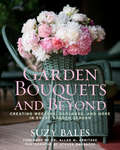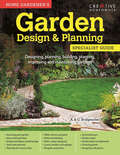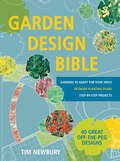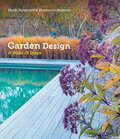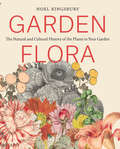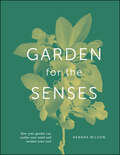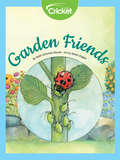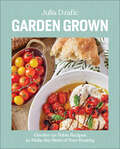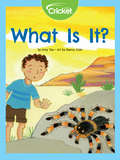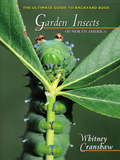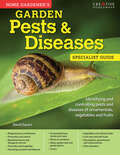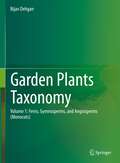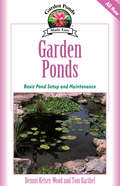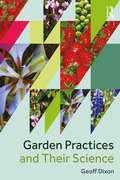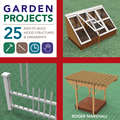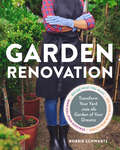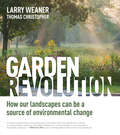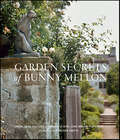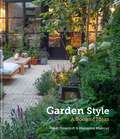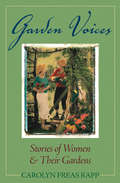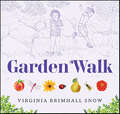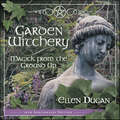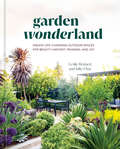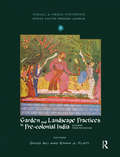- Table View
- List View
Garden Bouquets and Beyond: Creating Wreaths, Garlands, and More in Every Garden Season
by Suzy Bales<p>Suzy Bales sums up garden arrangements like this: "Life is best lived in sync with the seasons." She brings a new angle to four-season garden bouquets—gather the blooms, but don't overlook the leaves, branches, and vines you find in the off-season. <p>Her fresh-from-the-garden arrangements celebrate the ever-changing landscape and feature unique combinations of flowers and foliage for floral creations in every style.Lifelong gardener and lifestyle writer Bales also takes on the role as inspirational designer to educate gardeners about the latest research on conditioning individual garden flowers, how to care for them immediately after cutting, and the length of time they can be expected to last. <p>Garden Bouquets and Beyond: Creating Wreaths, Garlands, and More in Every Garden Season has compiled complete instructions for prolonging the bloom.
Garden Design & Planning: Designing, planning, building, planting, improving and maintaining gardens (Home Gardener's)
by Gill Bridgewater Alan BridgewaterLearn how to transform a bare patch or an existing layout into your dream garden with this guide taking you from initial planning to the finishing touches. Beginning gardeners and experts alike will appreciate this book of practical advice on virtually every aspect of gardening—from choosing a plot to selecting flowers and water features. The instructions and advice inside encompass plans and proven techniques for planting traditional English, Japanese, herb, and rock gardens, as well as building structures such as fences and walls, arches, pergolas, and trellises, plus decking and pathways. With more than three hundred color photographs, illustrations, and diagrams the Home Gardener&’s Garden Design and Planning Specialist Guide ensures that anyone can create a glorious garden!
Garden Design Bible: 40 great off-the-peg designs – Detailed planting plans – Step-by-step projects – Gardens to adapt for your space
by Tim NewburyDo you dream of transforming your back garden into a romantic retreat? Would you like to make a modern-day Utopia on your balcony? Is your ideal outdoor space a minimalist design with easy-to-care-for plants or a family garden with room to grow culinary herbs? Whatever your desire, the Garden Design Bible has a plan that you can adapt to your own space. Choose from 40 off-the-peg designs, or mix and match elements from several to create your ideal garden. Each of the designs is fully illustrated and has a comprehensive plant list and planting diagram. With a huge range of plants, styles and uses, this inspirational yet practical book is the next best thing to hiring a gardener!
Garden Design: A Book of Ideas
by Marianne Majerus Heidi HowcroftWinner of the Garden Media Guild Book Photographer of the Year 2015'This book will inspire readers to envision what is possible even in the smallest, most improbable spaces'.Publishers Weekly'Just looking at Marianne's stunning photographs made me want to go outside and start re-thinking my plot....I defy any reader not to find a style they can feel comfortable with in this book, there are plenty of ideas which can be adopted, even for the most difficult location'.Reckless GardenerThere is no one way to design a garden. The variations and breadth of possibilities are astonishing but it is the choices of the individual that make the world of gardens so exciting. Creating a garden is part common sense and part instinct but we all need inspiration to help us realize the garden we want. Garden Design: A Book of Ideas is the must-have visual reference for garden owners, architects and designers. With over 600 images by award-winning photographer Marianne Majerus and incisive advice from garden designer and best-selling writer Heidi Howcroft, this book takes the reader from getting the concept right to choosing the perfect finishing touches for your outdoor space. The gardens featured are large and small, urban and rural in a wide range of styles from contemporary to classical to naturalistic. Every aspect of designing a garden is explored, from assessing your plot and soil to choosing a style as your inspiration, selecting the right components (be they hard landscaping, boundaries or plants) and tackling more challenging spaces.
Garden Flora: The Natural and Cultural History of the Plants In Your Garden
by Noel Kingsbury“A beautifully illustrated reference book covers the origins, ecology and history of popular garden plants.” —Shelf Awareness The oldest rose fossil was found in Colorado and dates to 35 million years ago. Marigolds, infamous for their ability to self-seed, are named for an Etruscan god who sprang from a ploughed field. And daffodils—an icon of spring—were introduced to Britain by the Romans more than 2,000 years ago. Every garden plant has an origination story, and Garden Flora, by noted garden designer Noel Kingsbury, shares them in a beautifully compelling way. This lushly illustrated survey of 133 of the most commonly grown plants explains where each plant came from and the journey it took into home gardens. Kingsbury tells intriguing tales of the most important plant hunters, breeders, and gardeners throughout history, and explores the unexpected ways plants have been used. Richly illustrated with an eclectic mix of new and historical photos, botanical art, and vintage seed packets and catalogs, Garden Flora is a must-have reference for every gardener and plant lover.
Garden For The Senses: How Your Garden Can Soothe Your Mind and Awaken Your Soul
by Kendra WilsonRevive your senses and achieve a renowned sense of serenity through gardening.Our five senses — sight, touch, hear, smell and taste — are what connect us with the world around us. It&’s also what distinguishes our humanity in many ways. This inspirational gardening guide is a celebration of these senses and how they rejuvenate our very being through the act of gardening.Find out how this heartening gardening book can show you that by simply being outside you can be grounded and calm. You&’ll learn which plants to grow to nourish both your mental and physical well-being and more: • Separate sections on each of the senses, as they walk the reader through customizing their outdoor space for the best sensory experience. • Inspiring and evocative pull-out quotes and phrases help to heighten the understanding of each sense. • The clear and engaging text explains how each aspect stimulates a particular sense. • Beautiful and atmospheric photography brings the subjects to life. Immersing yourself in nature, whether it is smelling the scent of fresh flowers or strolling through a garden, has been known to be very effective in improving one&’s mood and energy. This enlightening guide walks you through all the different senses so you can tailor your garden to your specific needs and personal preferences. Sensory gardening is for everyone!Be inspired with fresh new ideas on planting and maintaining your garden, which you can put into practice quickly and easily. This guide to gardening shows you how you can improve the sensory enjoyment of your outside space no matter where you live and plot size. Garden For The Senses makes the perfect gift for gardeners, growers, cooks, designers and nature lovers. It is also appealing to those gardeners seeking a more sensory and mindful approach to gardening and who want to understand why being outside is so vital for wellbeing.
Garden Friends
by Faith HickmanGardens make great habitats for many types of animals. Water, protection and food are the benefits for animals living in a garden, and in return they keep the soil healthy, eat pesky insects, and help pollinate the flowers. Ladybugs are helpful to a garden–they eat insects called aphids. Find out which animals are a gardener’s best friends and which are enemies!
Garden Grown: Garden-to-Table Recipes to Make the Most of Your Bounty: A Cookbook
by Julia DzaficMake the most of your garden's bounty with over 100 vegetable-forward recipes from Lemon Stripes' Julia DzaficOn her popular blog Lemon Stripes, Julia Dzafic shares her life—motherhood, decor, lifestyle, wellness, cooking, and more—with thousands of readers. Julia's husband Anel is an avid gardener, and over the years, Julia has been taking their garden's bounty and experimenting with new recipes in the kitchen.The result is Garden Grown, an aesthetically pleasing garden-to-table cookbook packed full with over 100 colorful, easy-to-make, family-friendly, veggie-forward recipes and scattered with gardening tips along the way. Anel provides gardening tips for each type of produce, while Julia shares recipes near and dear to her heart and tips for how to store overflow to last throughout the offseason. With this book, you'll learn how to make the most of your garden&’s bounty all year round.
Garden Guesthouse: Is It What Jesus Intended?
by Nancy Cote Amy TaoHave you ever heard of a bug hotel? There are some insects that help plants by spreading pollen and improving the soil, but they don’t always show up in every garden. To help encourage them to move in, some gardeners build little houses for them!
Garden Insects of North America
by Whitney CranshawGarden Insects of North America is the most comprehensive and user-friendly guide to the common insects and mites affecting yard and garden plants in North America. In a manner no previous book has come close to achieving, through full-color photos and concise, clear, scientifically accurate text, it describes the vast majority of species associated with shade trees and shrubs, turfgrass, flowers and ornamental plants, vegetables, and fruits--1,420 of them, including crickets, katydids, fruit flies, mealybugs, moths, maggots, borers, aphids, ants, bees, and many, many more. For particularly abundant bugs adept at damaging garden plants, management tips are also included. Covering all of the continental United States and Canada, this is the definitive one-volume resource for amateur gardeners, insect lovers, and professional entomologists alike. To ease identification, the book is organized by plant area affected (e.g., foliage, flowers, stems) and within that, by taxa. Close to a third of the species are primarily leaf chewers, with about the same number of sap suckers. Multiple photos of various life stages and typical plant symptoms are included for key species. The text, on the facing page, provides basic information on host plants, characteristic damage caused to plants, distribution, life history, habits, and, where necessary, how to keep "pests" in check--in short, the essentials to better understanding, appreciating, and tolerating these creatures. Whether managing, studying, or simply observing insects, identification is the first step--and this book is the key. With it in hand, the marvelous microcosm right outside the house finally comes fully into view. Describes more than 1,400 species--twice as many as in any other field guide Full-color photos for most species--more than five times the number in most comparable guides Up-to-date pest management tips Organized by plant area affected and by taxa for easy identification Covers the continental United States and Canada Provides species level treatment of all insects and mites important to gardens Illustrates all life stages of key garden insects and commonly associated plant injuries Concise, clear, scientifically accurate text Comprehensive and user-friendly
Garden Pests & Diseases: Identifying and controlling pests and diseases of ornamentals, vegetables and fruits (Home Gardener's)
by David SquireLearn how to identify pests & diseases and take the appropriate actions to keep your garden safe—with an emphasis on non-chemical methods.Home Gardener&’s Garden Pests & Diseases is the essential guide to identifying, targeting, and banishing common pests and diseases from the garden. All gardeners know the disappointment of finding their flowers nibbled, or their prized produce riddled with rust. Armed with this essential guide, you can stop the destruction. Get acquainted with all the common pests and diseases that afflict ornamentals, vegetables, fruits, and houseplants, and learn the best ways to deal with them. The effective options include both biological controls—increasingly popular in the gardening world—as well as the better-known organic and chemical methods. At-a-glance checklists explain which ailments generally afflict various plant types, from roses and rock-garden plants to soft fruits and vegetables.
Garden Plants Taxonomy: Volume 1: Ferns, Gymnosperms, and Angiosperms (Monocots)
by Bijan DehganHorticulture has remained far behind in understanding of botanical principles. Recent phylogenetic (DNA-based) reorganization of higher plants has revolutionized taxonomic treatments of all biological entities, even when morphology does not completely agree with their organization. This book is an example of applying principals of botanical phylogenetic taxonomy to assemble genera, species, and cultivars of 200 vascular plant families of ferns, gymnosperms, and angiosperms that are cultivated for enhancement of human living space; homes, gardens, and parks. The emphases are on cultivated species but examples of some plants are often shown in the wild and in landscapes. In providing descriptions, it is assumed that students and other interested individuals have no background in general botany (plant characteristics), or nomenclature. Fundamental features of all plant groups discussed are fully illustrated by original watercolor drawings or photographs. Discussion of the families is grounded on recent botanical phylogenetic treatments, which is based on common ancestry (monophyly). Of course, phylogenetic taxonomy is not a new concept, and was originally based on morphological characteristics; it is the DNA-based phylogeny that has revolutionized modern biological classifications. In practical terms, this book represents the horticultural treatment that corresponds to phylogenetic-based botanical taxonomy, to which is added cultigens and cultivated genera and species. Hence, the harmony between horticultural and botanical taxonomy. This book covers phylogenetic-based taxonomy of Ferns, Gymnosperms, and Angiosperms (Monocots). A companion volume covers Angiosperms (Eudicots).
Garden Ponds
by Dennis Kelsey-Wood Tom BarthelIn this colorful Garden Ponds Made Easy title, authors Dennis Kelsey-Wood and Tom Barthell have provided an essential guide for first-time pond enthusiasts. The authors outline all of the considerations for starting out with a new pond, including determining the site, style, size of the pond, and deciding on the construction of the pond (whether preformed, concrete, or fiberglass). Garden Ponds offers a chapter on water which discusses water chemistry factors, volume of the pond, and pond surface. Other important factors involve the aeration, filtration, drainage, and maintenance of a clean (algae-free) pond. Special features, including waterfalls, fountains, and watercourses, electricity, and landscaping are addressed in detail, all accompanied by color photographs and drawings. A chapter on pond construction details every step of the project from creating a blueprint to securing the foundation. The infinite choices involved with stocking the pond with fish and plants can be overwhelming for the first-time pond owner, and the authors give excellent advice about making smart choices for a harmonious, beautiful garden pond. A special chapter on seasonal pond care gives the pond keeper recommendations for maintaining the pond all year long. Resources and glossary included.
Garden Practices and Their Science
by Geoff DixonWritten in a clear and accessible style, Garden Practices and Their Science guides gardeners in the practical arts of plant husbandry and in their understanding of its underpinning principles. The author, Professor Geoff Dixon, is an acknowledged and internationally respected horticulturist and microbiologist; he intertwines these arts and principles carefully, expertly leading readers from one to the other. Achieving the manipulation of plant life is described in eight full-colour, well-illustrated chapters covering the growing of potatoes, bulb onions, legumes, small-seeded vegetables, soft fruit, bulbs and herbaceous ornamentals in great detail. Environmental factors controlling the successful husbandry of these crops is described in simple, non-technical language, increasing gardeners’ enjoyment and competence. Gardeners are also informed of the tools and equipment they require and their safe use. Also provided are a series of simple, straightforward tests identifying the aerial and soil environments beneficial for plant growth using readily accessible domestic tools. Discussions of very straightforward techniques for vegetative propagation conclude this book. Each chapter ends with a list of the gardening knowledge that has been gained by readers. The structure of this book fulfils a longstanding need for descriptions of practical skills integrated with the corresponding biological reactions of plants. Emphasis is placed on gardeners’ development of healthy soils, which encourage vigorous, active root systems capable of withstanding stresses—an aspect of gardening that rarely receives sufficient attention. Tailored for readers requiring clear and concise directions, this very practical book is an instruction manual directed at early-stage gardening learners. These include people of all ages and requirements such as new garden owners, allotment-holders, apprentices and students of basic levels in the Royal Horticultural Society’s or City & Guilds qualifications, career changers, community gardeners and those needing applied biological knowledge for GCSE examinations.
Garden Projects: 25 Easy-to-Build Wood Structures & Ornaments
by Roger MarshallGarden Projects gives you a range of plans for useful and ornamental additions to your garden. Each project is fully explained, with detailed step-by-step descriptions and illustrations to guide you through. Garden Projects suit your needs and abilities, from practical and simple raised garden beds to more ambitious things, like a tool shed. There are more whimsical structures too--a flagpole, a garden swing, and an ornamental wheelbarrow for flower arrangements among them. Author Roger Marshall has carefully designed projects that don't require a vast array of tools or advanced woodworking skills. Every gardener will find ideas and plans to enhance his or her garden in this helpful book. Marshall applies his know-how and skillful delivery to a wide range of building projects that might take a weekend afternoon or provide a way to pass the time constructively on those dark winter days when you can't wait to get back out into the garden.
Garden Renovation: Transform Your Yard Into the Garden of Your Dreams
by Bobbie SchwartzA do-it-yourself guide to a complete garden rehab Gardens, just like houses, sometimes need makeovers. The changes can be as minor as replacing a shrub or as major as pulling everything up and starting from scratch. No matter the size of your space or the scope of the project, the sage advice in Garden Renovation will help you turn a problem-filled yard into a paradise. Bobbie Schwartz draws on her years of experience as a garden designer to teach gardeners how to evaluate their yards, determine what to keep and what to remove, choose the right plants and design plans for successful remodels, and know when to hire help. A gallery of before-and-after photos provides ideas and inspiration for turning a tired garden into an enlivening retreat.
Garden Revolution: How Our Landscapes Can Be a Source of Environmental Change
by Thomas Christopher Larry WeanerAHS Book Award winner This lushly-photographed reference is an important moment in horticulture that will be embraced by anyone looking for a better, smarter way to garden. Larry Weaner is an icon in the world of ecological landscape design, and now his revolutionary approach is available to all gardeners. Garden Revolution shows how an ecological approach to planting can lead to beautiful gardens that buck much of conventional gardening’s counter-productive, time-consuming practices. Instead of picking the wrong plant and then constantly tilling, weeding, irrigating, and fertilizing, Weaner advocates for choosing plants that are adapted to the soil and climate of a specific site and letting them naturally evolve over time. Allowing the plants to find their own niches, to spread their seed around until they find the microclimate and spot that suits them best, creates a landscape that is vibrant, dynamic, and gorgeous year after year.
Garden Secrets of Bunny Mellon
by Linda Jane Holden Thomas Lloyd Bryan HuffmanGarden Secrets of Bunny Mellon is for anyone who has enjoyed time spent in a garden, from aspiring garden makers to those who manage large estates. This collection is comprised of extracts from Bunny’s own writings and garden notes, as well as photographs and drawings from her archive. Chapters are organized by Atmosphere (sky, horizon, shadows), Climate, Light, Space, Shape, Maintenance, and more―readers will feel as if Bunny Mellon has come alongside as a gardening guide and friend. Bunny Mellon was of the affluent class and mingled along with her husband, Paul Mellon, in the circles of the East Coast gentry of the Kennedy and Reagan eras. But Mrs. Mellon, as she was respectfully called by those professional gardeners who worked with her most, wasn’t afraid to get her hands dirty in the rich soil of her family’s Virginia farm. Beyond this, Bunny Mellon was known nationally and internationally as a style icon of her time, enjoying friendships with Givenchy, the Kennedys, and the like. Her personal passion was for design, and that was exhibited in her fashion and her garden. A trusted author, Linda Holden learned that Bunny wanted to write a gardening book but never found the time. Searching the family’s archive after Mrs. Mellon’s death, the editors―whom all shared personal relationships with Bunny―discovered a trove of photographs, illustrations, and writings and have now turned it into the how-to gardening book Bunny had hoped to write.
Garden Style: A Book of Ideas
by Marianne Majerus Heidi HowcroftGardens have never been as important as they are today. The breadth of styles and types is hugely varied. Everything goes, whether inspired by the past or looking towards the future, from traditional vegetable plots to vertical gardens and from nature-filled designs to sleek, modernist creations. Choosing what suits your space can be a daunting prospect and everyone, even the professionals, needs help to realize opportunities and create outdoor spaces in tune with their personal needs and dreams. A garden is what we make it: there is no right or wrong way and each is unique.Richly illustrated by the photos of award-winning photographer Marianne Majerus and with illuminating text by landscape architect Heidi Howcroft, this book shows what is possible for every type of garden, from challenging small spaces to expansive plots. Design tools are explained, planting styles explored, and inspiration is drawn from a wide variety of locations and climates to appeal to garden owners and designers everywhere.The book is not only a companion to Garden Design: A Book of Ideas but is also a valuable style catalogue and sourcebook in its own right, encouraging and inspiring readers to discover their own garden style - be it contemporary or traditional, cottage-style or urban minimalist.
Garden Style: A Book of Ideas
by Marianne Majerus Heidi HowcroftGardens have never been as important as they are today. The breadth of styles and types is hugely varied. Everything goes, whether inspired by the past or looking towards the future, from traditional vegetable plots to vertical gardens and from nature-filled designs to sleek, modernist creations. Choosing what suits your space can be a daunting prospect and everyone, even the professionals, needs help to realize opportunities and create outdoor spaces in tune with their personal needs and dreams. A garden is what we make it: there is no right or wrong way and each is unique.Richly illustrated by the photos of award-winning photographer Marianne Majerus and with illuminating text by landscape architect Heidi Howcroft, this book shows what is possible for every type of garden, from challenging small spaces to expansive plots. Design tools are explained, planting styles explored, and inspiration is drawn from a wide variety of locations and climates to appeal to garden owners and designers everywhere.The book is not only a companion to Garden Design: A Book of Ideas but is also a valuable style catalogue and sourcebook in its own right, encouraging and inspiring readers to discover their own garden style - be it contemporary or traditional, cottage-style or urban minimalist.
Garden Voices
by Carolyn Freas RappCountless garden books tell us what, when, where and how to plant.Few explore the reasons why gardening becomes central to so many people's lives.<P><P> In Garden Voices, Carolyn Rapp explores the relationships of women with their gardens, revealing sources of joy that go far beyond the pleasure of harvesting flowers, herbs or vegetables.<P> As the 12 women tell their stories, readers will share the heartache and triumph set within plots of lovingly cultivated land.Everyone who reads Garden Voices will hear a whisper of themselves in the words of these creative, courageous, wise women.This is not just a book for people who love gardens; it's for people who love stories.
Garden Walk (Seasonal Walks)
by Virginia Brimhall SnowTake a stroll through a magnificent garden and serene forest with Grammy and her grandkids and find out what there is to discover around every turn. Beautiful illustrations and adorable rhymes will guide readers as they learn to identify different kinds of flowers, fruits and berries, trees, birds, insects, and animals. Pick and snack on fruits in the garden, and then swing in a huge tree right after you have a picnic in the forest.
Garden Witchery: Magick from the Ground Up
by Ellen DuganHow does your magickal garden grow?... With violets, rosemary, and yarrow to attract faeries; an apple tree for love and health; and a circle of stones in some tucked-away corner? Whether you live in a cottage in the woods, a home in the suburbs, or a city apartment with a small balcony, a powerful and enchanted realm awaits you. Discover the secret language and magickal properties of the trees and flowers, herbs and plants found growing around you, and learn how to create your own witch's garden.Written with down-to-earth humor by a master gardener who is also a practicing witch, this creative and encouraging guide will inspire gardeners of all ages and experience levels. It includes a journal section that makes it easy to keep track of your progress, practical gardening advice, personal stories, and garden witchery lore and magick. Inside, you'll get the dirt on:Flower folkloreMoon gardening and astrological timingFaerie magickBeginning to advanced witchcraftFloral and herbal spellsSabbat celebrationsWitch crafts (sachets, wreaths, charm bags)Creating sacred spaceShade, moonlight, and sun gardensEnchanted houseplant and container gardensMagickal herbal correspondencesGarden blessings2004 COVR Award Winner
Garden Wonderland: Create Life-Changing Outdoor Spaces for Beauty, Harvest, Meaning, and Joy
by Leslie Bennett Julie ChaiA visual feast of garden design inspiration that embraces diversity and teaches you how to create a lush, colorful, edible, and meaningful garden wonderland of your own.&“Through story and imagery, Garden Wonderland reminds us over and over that plants should be part of everyday for everyone: as food, experience, memory, and creativity.&”—Jennifer Jewell, creator and host of the Cultivating Place public radio program and podcast, and author of What We SowAward-winning garden designer Leslie Bennett creates gardens filled with stunning layers of color and texture. But even more than that, they &“feed the eye and nourish the soul&” (Elle Decor).Featuring practical how-to information alongside examples from nineteen gardens, Bennett shows how to incorporate personal and edible elements into the landscape to honor a variety of cultures, while including families of all shapes and sizes, to create space that nurtures self, community, and more. For example, the team designed a garden for the cofounder of the Dr. Huey P. Newton Foundation to showcase art from emerging Black artists, while for a vegan chef's garden, they incorporated unusual vegetables that can't be found in grocery stores. A garden for a daughter of diplomats reflects the many places she's lived around the world; for a family that wants to beautify their neighborhood, they designed a vibrant community-oriented front yard.With chapters on floral, edible, gathering, healing, and cultural wonderlands, Bennett provides advice for tailoring a garden to your own needs, whether it's a place to host elegant garden parties, for children to play, to grow your own food and creativity, or a sanctuary to rest and relax. In Garden Wonderland, Bennett helps you unlock the potential of your garden to become a space of inspiring natural beauty, abundance, connection, and belonging.
Garden and Landscape Practices in Pre-colonial India: Histories from the Deccan (Visual and Media Histories)
by Daud Ali; Emma J. FlattThis book presents a set of new and innovative essays on landscape and garden culture in precolonial India, with a special focus on the Deccan. Most research to date has concentrated on the comparatively well preserved gardens and built landscapes of the celebrated Mughal empire, giving the impression that they have been lacking in other times and regions. Not only does this volume provide a corrective to such assumptions, it also moves away from traditional art-historical approaches by posing new questions and exploring hitherto neglected source materials. The contributors understand gardens in two related ways: first as real or imagined spaces and manipulated landscapes that are often invested with pronounced semiotic density; and second as congeries of institutions and practices with far-reaching social ramifications for the constitution of elite societies. The essays here present a multi-disciplinary approach to the study of garden culture in precolonial India, and together suggest several new and exciting directions of enquiry for those working in the Deccan, Mughal India, and beyond.
